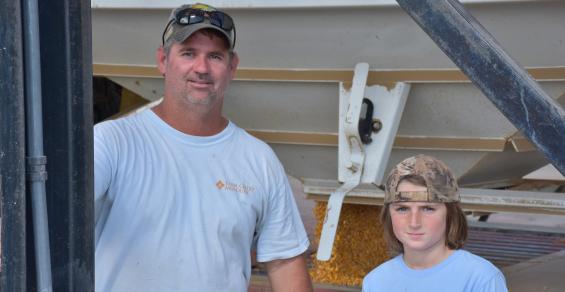In addition to variety selection and rotation, Michael Taylor follows a proven management regime.
Aggressive rotation and variety selection top the list of critical management practices Michael Taylor depends on to hit yield goals on corn, cotton, soybeans, and peanuts.
Taylor farms 4000 acres of land that’s been in his family since 1938, about 60 miles south of Memphis by the Mississippi River near Helena, Ark.
“Rotation is huge on every crop, one of the most important things I do,” Taylor said. “We sometimes plant beans behind beans because I have more acres in soybeans. We don’t plant corn behind corn.”
He said corn following any other crop is beneficial. “I am happy with any rotation crop ahead of corn.”
He said in his area, a lot of ground is more suited to soybeans, so beans on beans, especially on ground “we can’t get water to, may be our best bet.”
Taylor always plants peanuts behind cotton and follows a strict 4-year rotation on peanut acreage.
Research plots
Taylor plants corn and soybean trials for Northrup King, Pioneer, Asgrow, and DEKALB.
“Those trials help with variety selection every year,” he said. “I can see the potential of the corn hybrid on my fields. Just because a hybrid does well 25 miles away doesn’t mean it will do well on my farm.
“We switch hybrids pretty often when we see something in a trial that looks promising. We also get to look at new hybrids and varieties a little sooner. We have the ability to look at them on our fields and are ready to get new ones when they come out. We get a look at them before they hit the market. If I’m thinking about planting something new on my dirt, I want to see the potential.
“For corn hybrids, I look at standability, plant height, and ear placement. I look at lodging on soybean varieties.”
Taylor said corn trials are only with DEKALB. For soybeans, he looks at Pioneer, NK, and Asgrow. He plants 100% DEKALB corn. He plants Pioneer and Asgrow soybeans, about half and half, and 100% Deltapine cotton.
Taylor likes the options he has with DEKALB corn hybrids. “On marginal, dryland ground, DEKALB offers durable hybrids. On good, irrigated land, we can get a racehorse hybrid.”
He irrigates 85% of his acreage, “pivot and furrow.”
Management system
In addition to variety selection and rotation, Taylor follows a proven management regime. He tills as little as possible.
“I follow the combine with bedders on 60-inch row spacing and plant a cover crop, one pass,” Taylor said. “I will do limited tillage behind corn because of residue and slugs. I’ve had some slug issues behind corn. I just combine and run a chopper, bed, spray, and plant, one tillage pass.”
Taylor has used a cover crop for about 25 years, usually cereal rye. “The ground blows really bad if we don’t plant a cover. When the wind starts blowing, it beats seedlings to the ground. If we don’t do something, we also get erosion and gullies. We have a love/hate relationship with cover crops, but the benefits outweigh the challenges.”
Fertility
Taylor’s corn fertility program includes 50 units of liquid nitrogen applied with the planter, 2-by-2. “We come back with 150 units of 28-0-0-5 with a knife rig. We fly on 100 pounds of urea, 46% nitrogen, pre-tassel.
“We may touch some low areas with another shot of urea,” Taylor said. “If we have low spots in fields where we might lose some nitrogen to excessive rainfall, we’ll fly on extra fertilizer.”
Weed control
Pigweed and ryegrass are his major weed problems.
Weed control starts with a burndown treatment of Dicamba/Roundup two to three weeks ahead of planting. “Behind the planter, we run 26 ounces of gramoxone, one pint of Dual, and Karate for cutworms in the cover crop,” Taylor said.
“After the knife rig runs, we come back with a full rate of Atrazine and Halex GT.”
Promising corn crop
He said 2022 corn looks “pretty good” so far, despite weather challenges. “We have been hot and dry. We have watered more this year than we ever have. But the corn is holding up well and just needs one more rain. Cotton has a ways to go but is loading up fast.”
Taylor said one irrigation well had been shut down only four days in the last 50 by late July. “We’ve had some rain but never more than an inch. We have received one half-inch rain and two one-inch rains.”
He said the hot, dry weather has been doubly challenging this year. “Crop inputs are expensive. We are watering twice as much as usual and paying twice as much for fuel.”
Taylor said these conditions are unusual for his area. “Drainage is usually as important as irrigation.”
Yield goals
Taylor said the overall management plan is to hit yield goals consistently. “Corn yield goal is 240 bushels. I want 1,400 pounds an acre cotton, 5,000 pounds per acre peanuts and 70 bushels per acre with soybeans. We don’t always hit these numbers, but that’s the goal at planting.”
Taylor, 43, has been farming with his dad since high school. “The family moved here in 1938 and has a long history of farming.”




